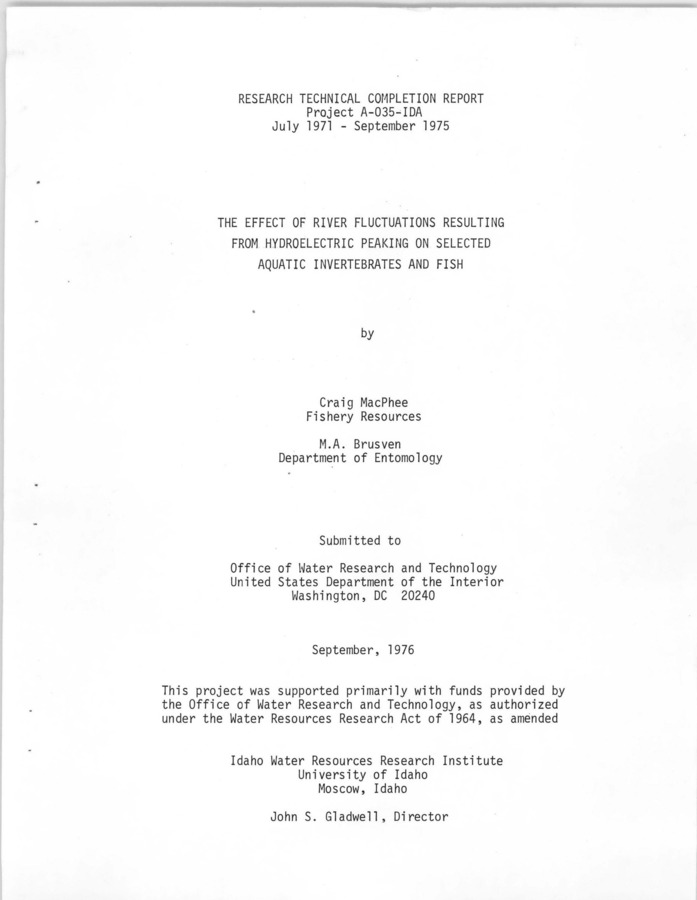PDF
The effect of river fluctuations resulting from hydroelectric peaking on selected aquatic invertebrates and fish. Research technical completion report, project A-035-IDA Item Info
- Title:
- The effect of river fluctuations resulting from hydroelectric peaking on selected aquatic invertebrates and fish. Research technical completion report, project A-035-IDA
- Authors:
- MacPhee, Craig; Brusven, M. A.
- Date Created (ISO Standard):
- 1976-09
- Description:
- Diel changes in discharge caused by hydroelectric peaking directly affect water levels and velocities and indirectly alter benthos and fish abundance and distribution. The effect of discharge on aquatic insect population below Dworshak Dam on the Clearwater River, Idaho was measured during different peaking regimes. Insects were sampled using a cylindrical bottom sampler, drift nets, basket samplers and embedded canisters. The benthic insect community below Dworshak Dam has remained relatively stable during and after the filling of Dworshak Dam but shorelines experiencing daily fluctuations are not readily colonized by stoneflies, mayflies and caddisflies; chironomid midges are the most resilient stranded insects in these unstable areas and the first ones to recolonize the flooded areas. The insects collectively reflected an obvious diel drift pattern with largest numbers drifting at night. Samples selected from three depths (15, 30 and 45 em) yielded the largest numbers of insects at the 45 em depth. When converting numbers of drifting insects to a volume-flow relationship, largest numbers of insects were captured at the 15 em depth. Basket sampling at depths of 1 and 2 m revealed no major differences in the insect community at these depths. A total of 98 species from eight orders of insects were recorded from the Clearwater River. Flows in a diversion channel (3.5 m in width) on the South Fork of the Salmon River were manipulated to experimentally simulate flow fluctuations below a power dam. An upstream section (20m in length) tested insects; a downstream section (60 min length) tested fish at 24-hour sequences of 57, 17, 3 and 51 1/sec. Analysis of vertical distribution of insects in the controlled flow channel indicated that the insects did not generally seek greater interstitial depths during dewatering and that many of the insects had become displaced via drift during the dewatering cycle. Stepwise reduction of discharge caused corresponding reductions in the number of chinook salmon (Oncorhynchus tshawytscha). The carrying capacity of the channel was 250% greater in the summer when salmon were smaller (<59 mm) and stream temperatures were higher (8-17 C) than in the fall when fish were larger (95-102 mm) and temperatures lower (4-15 C). Although the summer and fall carrying capacities differed, the proportion of fish remaining in the channel after each reduction in flow was about the same. The number of chinook in an experimental laboratory flume also changed directly with variation in the rate of flow. These findings corroborated with those for the diversion channel. Extreme reductions in flow significantly increased the amount of insect drift and the rate of ingestion by salmon in the diversion channel.
- Subjects:
- hydroelectric power flow velocity aquatic insects population density
- Location:
- Clearwater River
- Latitude:
- 46.51
- Longitude:
- -116.3
- Collection:
- IWRRI
- IWRRI number:
- 197610
- Rights:
- In copyright, educational use permitted. Educational use includes non-commercial reproduction of text and images in materials for teaching and research purposes. For other contexts beyond fair use, including digital reproduction, please contact the University of Idaho Library Special Collections and Archives Department at libspec@uidaho.edu. The University of Idaho Library is not liable for any violations of the law by users.
- Publisher:
- University of Idaho
- Contributing Institution:
- University of Idaho
- Type:
- Text
- Format:
- application/pdf
- Cataloger:
- wbv
- Date Digitized:
- 2012
Source
- Preferred Citation:
- "The effect of river fluctuations resulting from hydroelectric peaking on selected aquatic invertebrates and fish. Research technical completion report, project A-035-IDA", Idaho Waters Digital Library, University of Idaho Library Digital Collections, https://www.lib.uidaho.edu/digital/iwdl/items/iwdl-macphee_1976.html
Rights
- Rights:
- In copyright, educational use permitted. Educational use includes non-commercial reproduction of text and images in materials for teaching and research purposes. For other contexts beyond fair use, including digital reproduction, please contact the University of Idaho Library Special Collections and Archives Department at libspec@uidaho.edu. The University of Idaho Library is not liable for any violations of the law by users.
- Standardized Rights:
- http://rightsstatements.org/vocab/InC-EDU/1.0/

